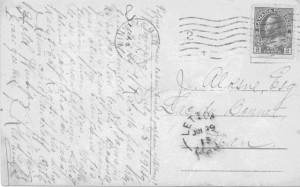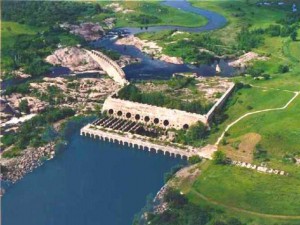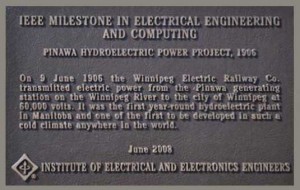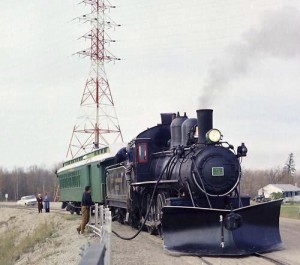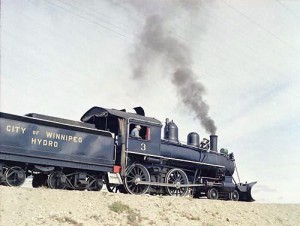Category Archives: District
Marie-Claire Granger: People of Fatima
Marie-Claire Granger shared her extensive research with the Lac du Bonnet & District Historical Society in July 2022.
For the full version, please click: People of Fatima
Short version: People of Fatima - Short
Granger Family Fatima History: Fatima et lé Grangers
Fatima was a district located approximately midway between Stead and St-Georges.
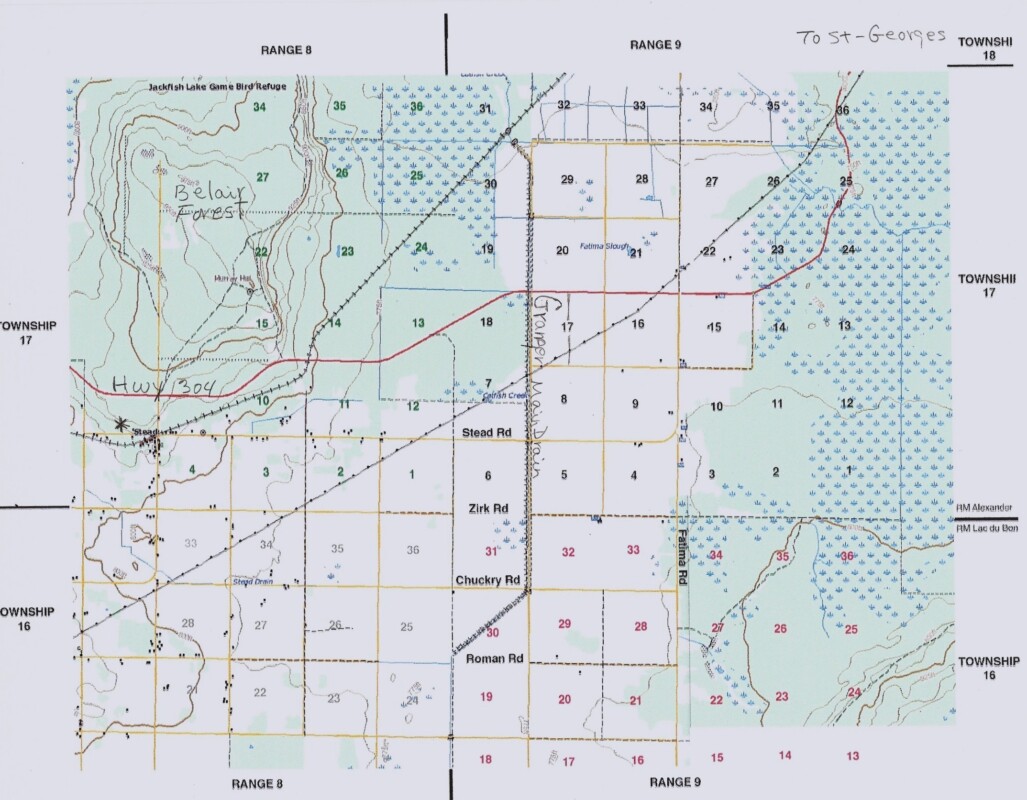
Marlene Tuokko: Poplar Bay & Bird River
Maple Creek, Landerville, and Crescent Bay
The French were the first Europeans to penetrate the western region of Canada and extend their sovereignty and institutions onto the prairies. They were the first to come into this native territory, the first to establish commercial relations, the first to establish a military presence, and the first to establish missions and schools.
Pierre Gautier de Varennes, Sieur De La Verendrye, and his sons had a dream to discover the “ Western Sea” and between 1731 and 1739 they were active in building the first trading posts on the prairies promoting the fur trade and gathering information and pushing back the frontiers of New France as far as Manitoba. Under their watch much of the fur trade was diverted to the St. Lawrence River from Hudson Bay. La Verendrye was credited with the naming of our lake, as it resembled the shape of a bonnet.
It was 160 years after La Verendrye that a number of French Canadians either from Quebec or Acadie came to this area. A number of them lived in the United States prior to moving to the Lac du Bonnet area. About 1899 some of these early French settlers obtained work with the Lac du Bonnet Mining, Manufacturing, and Developing Company under Walter Wardrop, and later J.D. Mc Arthur. Under this company they built and worked the brick factory and sawmill. Work was also obtained at the Pinawa Dam.
Religion and the church are very important to the French communities. Father Louis De Gonzague Belanger is credited with building the first Notre Dame du Lac Parish in Lac du Bonnet. The building was constructed in 1904 with the help of Louis Bruneau and other church members. Lac du Bonnet’s first school was opened in 1903 -1904 with the school being bilingual until 1916.
Many settled in and near the village of Lac du Bonnet, whereas other French families homesteaded in surrounding districts known as Maple Creek, Landerville, and Crescent Bay.
Maple Creek
is a district about 12 miles NW of Lac du Bonnet, homesteaded mainly by the French settlers.Maple Creek was named after the large number of huge Manitoba maple trees (Box Elder) along the banks of a small creek that twisted and turned through the district emptying into Crescent Bay (before Mc Arthur Dam).
Settlers were attracted by the offer from the government for $10.00 homesteads consisting of 160 acres. At this time there were no roads and it took two days from Lac du Bonnet by wagon through swamp and bush. Small mixed farming was done in Maple Creek, with men taking on extra work in bush camps cutting pulp.
Francois and Marie Lussier were two of the earliest homesteaders in 1919. Omer Lavoie operated a small sawmill in Maple Creek, and Mr. and Mrs. Henry Belair operated a small store on their farm until they moved to Lac du Bonnet in 1950.
In 1937 while Maple Creek School was being built across the road from the Lussier farm, a temporary school was held in their former log home. The new school was built by Edgar Paul, Armand Tetrault, and Noel Henri. It was used until 1965 after which the rural school children were bused to Lac du Bonnet.
Lussiers old log cabin then became a chapel where a priest would come on a mission during the months, when the weather was favorable, to hold baptismal and mass.
Maple Creek Cemetery is located on the Francois Lussier homestead farm and holds graves dating back to 1930.
Landerville
is a district about 7 miles NW of Lac du Bonnet. The area was first settled by a majority of Ukrainian and Polish settlers as early as1905 with some French families homesteading by 1910.
Landerville School and teacherage were built about 1918 with Mrs. Henley as the first teacher. Landerville also had a community hall, at the corner of Landerville and Maple Creek road, and a small country store run by Bill Kabaluk, across from the school yard.
Landerville Cyclone May 10, 1922
The weather was a dull grey prior to the lunch period. It looked like a storm was brewing over the small community of Landerville, seven miles north of Lac du Bonnet. About 1:30 pm all fury broke out. As the cyclone uprooted nearby trees, moved Landerville School off its foundation, and totally demolished the teacherage.
“ I was playing outside with my cousin Jean, who was about my age. Suddenly the sky became very dark and a wind came up. Then we noticed a huge dark V-shaped cloud complete with large raindrops. We were rather frightened and about to go indoors, when we heard frantic cries up the road. One of our cousins, Francis, A boy from the school, was hysterical and telling us that everyone at the school was dead. Immediately the men and whoever could help rushed to the school. They found that a cyclone had smashed Uncle Stanley’s house and lifted the school from its foundation”.
Stanley Pitre was the school teacher at the time.
An excerpt from Marcel Pitre’s book “Pitre Family Reunion July 1999
Crescent Bay
is about 6 miles north of the village of Lac du Bonnet named for the crescent shaped bay on the west side where the Winnipeg River expands to form Lake Lac du Bonnet.
Crescent Bay School was constructed in 1934 with Miss Ann James as the first teacher. French families that settled in this district were Bruneau, Picard, and David among others.
A large portion was flooded in 1953 when Mc Arthur Falls Power Plant began operations.
Brightstone
Lac du Bonnet’s early immigration mix has brought people here from many different countries. Let us focus on the Ukrainians who settled in Brightstone, Landerville, and Red Deer.
Ukrainian immigrants came to Canada hungry for land. All the land in the Ukraine was controlled by landlords and divvied up into small lots among a large population. Canada, however, had an open West that was almost totally unsettled. This is what attracted so many immigrants to Canada at the turn of the century: the land rush and the opportunities of homesteading.
The first wave of Ukrainian pioneers settled in Manitoba between 1891 and 1914 coming from Poland, Western Ukraine, and other Eastern Slavic countries. Some of the areas the Ukrainians settled in were Cloverleaf, Cooks Creek, Ladywood, Tolstoi, Vita, Gardenton, Brokenhead, and Brightstone which was eight miles West of Lac du Bonnet. The second wave occurred from 1918 to 1939.
Under the Dominion Lands Policy, homesteading immigrants received one hundred and sixty acres of land for the price of a $10 registration fee. Immediately after they arrived, they set out on years of grueling work. As homesteaders they had to break and clear a certain amount of land every year and get it into production in order to keep their homestead. The homesteaders' specified areas of land had to be cultivated within three years, which meant never-ending and back-breaking labor.
Ukrainians gave the community the name “Brightstone” after a large hill of granite outcropping that shone with the morning dew and the reflection of the sunlight. When they arrived in Brightstone, they had to build a house, often of log or sod construction. Wide spruce logs, maybe four to a wall, would be cut from nearby. And then sod or clay mixed with straw to hold it together would be slapped on to keep the harsh weather out. The more refined houses would have a basic whitewash applied over top of the clay.
They were faced with incredible hardships and bitter cold winters, with summers full of mosquitoes and black flies. A new homesteader would start clearing the land by hand, cutting trees with an axe, burning the underbrush, and clearing roots and stumps with the help of a team of oxen, since horses would have been far too expensive. Food was obtained from the land like berries, nuts, and mushrooms, and from a vegetable garden planted. Game was hunted to supplement the food supply. If the water supply was poor, homesteaders had to collect rainwater or melt snow or take on the grueling task of hand digging a well.. . Farming gradually improved from flailing grain to the thrashing machine of the 1920s.
The railways often provided a much needed source of work and extra income for homesteaders. Many were also forced to work other jobs to get enough money to buy the necessary farm equipment and keep the family and farm going. During the 1920s and 30s up to thirty oxen teams went to Lac du Bonnet to sell wood from the Brightstone district.
The land was the fruit of the homesteaders' labor. They put a lot of blood, sweat and tears into it and sometimes it was generous in return. Other times it took its toll on people. Homesteaders and their families were often separated from friends and relatives and many suffered years of hardship and loneliness. The men often left their wives and children to seek work forty miles away by foot on a section gang or lumber camp or twenty miles to the Pinawa Hydo Power Plant.
One of the greatest difficulties was the absence of roads and bridges. Most trails were impassable when wet. In the autumn homesteaders waited until the ground was frozen before transporting their produce to Lac du Bonnet. The roads were always terrible and it took years for them to be all season. The roads began as trails around swamps, then corduroy roads, and finally ditches and drainage were implemented.
Adversities, however, also bound homesteaders together. Prejudices were lessened as people helped one another. Doors were kept unlatched and lanterns hung at night to guide travelers. And as communities developed, there were sport days, country fairs and a variety of entertainment at the community hall or church.
There was a special bond that was created between the immigrants that came here, opened up the West and farmed it. There was almost a spiritual bond among themselves, and with the earth.
Brightstone began with the establishment of a cemetery, followed by St. Mary’s Polish Roman Catholic Church where in 1936 thirty local families attended, which is approximately 130 people attending service. A post office opened with John Stanko as the first and only postmaster from 1913 to 1944. A one room schoolhouse opened in 1912 with Leona Gorecki as its first teacher. Brightstone school colors were red and white. John Hollop opened the first store in 1919, Jacob Hapko was the coffin maker and barber from 1914 to 1935, and John Malyk was the local Brightstone blacksmith.
A community hall was built in 1925 and in 1937 the Ukrainian Catholic Church was started. The Wojciechowski family had the first horses in the district in 1913, and he was a cooper or barrel maker. The CO-OP store began in 1938 and ran till 1968.
Ukrainian immigrants were profoundly Christian people. The faith was deeply ingrained in them and they brought this deep faith with them when they came to Canada. The Ukrainian settlers brought with them traditional customs and folk lore.
Lettonia, Bird River, and Lee River

Latvian men in Boston USA 1908 - John Ulman, John Beckman and the Belgin brothers came to Lettonia soon after. ~ photo courtesy of Vivian Nespar
Latvia is a country in the Baltic region of northern Europe. About 1905 there was a failed revolution to over throw the land owners or German Barons by the Latvians to regain control of their own schools and activities. Consequently several thousand Latvians escaped persecution by fleeing to freedom in North America or South America. At that time Brazil, the United States, and Canada were advertising golden lands of opportunity and free homesteads.
The Latvians migrated to Manitoba from Brazil and the United States. Latvian families took up homesteads in Libau, Lettonia, Newcombe, Lee River, Bird River, and Sifton areas from the early 1900’s to the 1930’s.
Homesteads on the river were acquired “sight unseen” due to the lack of roads and the fact that the river was the only way of transportation. It is amazing how one would have to paddle 25 miles into the wilderness to locate their quarter section of land on the Bird River.

Bird River homesteaders August 15, 1921 - Back row: Ed Peterson, Willis Gulbis, John Ledin, Mikel Osis, George Drawson Sr. Front Row: Lapin Greikst, and Peter Preede. ~ photo courtesy of R.E. Emmett
The homesteaders had to clear land, build a house, and live on the land at least part of the year. Most had to work away for a portion of the year on threshing, trapping, prospecting, laboring at Pointe du Bois, Pinawa Dam, and Lac du Bonnet Brick Works, cutting wood or other jobs.
As an example of the amount of cord wood cut between 1912 and 1920, one mile East of Lee River F. Hestrin & Sons were shipping out 5 or 6 boxcar loads a week. They had 1 thousand cords stacked up awaiting available box cars to ship to Winnipeg at one time.
Newcombe and Lettonia are approximately 10 - 18 miles NE of the village of Lac du Bonnet. This area was settled primarily of Latvians with a sprinkling of Swedes and Norwegians. Lettonia means Latvia or land of the Letts in French. Lettonia was born when the post office was opened in 1913 with John Alksne as first postmaster. John Alksne also donated a portion of his homestead for the Lettonia cemetery.
Eventually small mixed farming commenced, raising cattle, pigs, chickens, sheep, turkeys, and some dairy and fur farming of fox and mink began.

John Peterson’s water powered sawmill at the junction of Bird River and Peterson Creek. ~ photo courtesy of Trethart
John Peterson built a saw mill at the junction of Peterson creek and Bird River that supplied lumber for the surrounding homes. Newcombe school was built in 1915 near Lettonia, Bird River and Lee River school construction followed in 1919 -1920.
John and Annie Mathews donated a piece of land jetting out into the water, not far from their home, where Lettonia Hall was built in the 1920’s. This hall was the centre of activities for people from Bird River, Lee River, and Newcombe for socials, bazaars, plays, dances, and Christmas concerts. A community hall was also built at Lee River.

Lee River Hall with kitchen portion removed. From the 20s to the 50s it was the popular spot for weddings, dances, socials, and get-togethers. ~ photo courtesy of Ves Zarins
This hall was a 12 mile sleigh ride from Bird River and had a polished wood floor, a stage at one end, and a kitchen at the other with a balcony overlooking the dance floor below.
Latvians contributed greatly to mineral exploration and the discovery of copper, chromite, and other minerals north of the Winnipeg River in the 1920s to 30s especially Bernic Lake and Bissett areas.
About 1951 their lands were expropriated by Manitoba Hydro for the building of the McArthur Dam for bay. Homes and barns were moved or demolished. The waters were raised 5 meters or 16 feet with a vast portion of Lettonia, Newcombe, Lee River, and Bird River disappearing beneath the waters.
Looking at the Lac du Bonnet District museum 2014 display you can capture our Latvian heritage through photos and artifacts and understand the impact Latvians had in this area. The names Libau, Lettonia, Grausdin Point, Gulbis lake , Osis lake, Anson lake, Sarapu lake, and Lapin Lake bear testament to our Latvian homesteaders.
Pinawa Dam Heritage Park & Pinawa
A comprehensive History of the Pinawa Dam as a generating station can be obtained at these locations:
- Pinawa Dam History - Friends of Old Pinawa
- Pinawa 1906-1951 - Manitoba Electrical Museum, Inc.
Pinawa Dam Heritage Park
The park is located beside highway 520. The location of this park was originally a hydroelectric dam built between 1903-06 to provide electricity to the province of Manitoba and the city of Winnipeg. Strangely, it was not until after this facility closed that neighbouring communities received electrical power. It is one of many locations in the area like Slave Falls, McArthur Falls, Great Falls, Pointe du Bois and Pine Falls where the energy of the Winnipeg River is harnessed to develop electrical energy.
This generating station closed in 1951 and was partly demolished. The Canadian Army took it over and used the remaining Pinawa company town site houses and other buildings to stage battle scenes and effectively turned them into war-zone rubble. Then they left.
In 1986 the Manitoba Government, Department of Natural Resources re-named it Pinawa Dam Heritage Park, and it was open to the general public again. It is cared for by a dedicated non profit group of volunteers called The Friends of Old Pinawa.
The Pinawa Dam Heritage Park is commonly referred to as Old Pinawa Dam. Ever since the hydro operations ceased it has been a favorite gathering place for area teenagers during daytime and night-time. A sign stating that swimming can be dangerous has never stopped some daring people from enjoying its warm rapids. By late summer the water tumbles down with less gusto allowing those with nimble feet to walk across over the slippery moss covered rocks. Others use the rapids as a waterslide.
The Friends of Old Pinawa have worked diligently through the years to make what remains of the dam site safe for hiking, and the grounds tidy for families and other groups of people to enjoy. The Trans Canada Trail and a hiking trail go through the park and follow the Pinawa Channel. Snowmobilers drive through in wintertime.
Compiled by:
Miriam Simoens, Secretary
The Lac du Bonnet and District Historical Society Inc. June 2010
The Town of Pinawa, Manitoba (built in 1963)
The only way to enter the town of Pinawa by vehicle is to drive to the end of Highway 211. Pinawa is situated beside the Winnipeg River and at the northern edge of the Whiteshell Provincial Park.
The name comes from a First Nations term for calm water. The town built by the Canadian Government for Atomic Energy (AECL) to provide housing and recreation for the the employees of its research station located several miles away. The station is presently being de-commissioned so the town gradually changing from a company town to include cottages and tourists.
Pinawa offers many summer recreation possibilities such as boating, canoeing, fishing, hiking, biking and swimming. The Trans Canada Trail goes through here. There are wonderful hiking trails like the Ironwood Trail, Alice Chambers Trail and the Pinawa Chanel Heritage Walk. It offers an excellent nine hole golf course. During winter there is cross-country skiing, snowmobiling, skating and curling. The Eastern Manitoba Concert Association (EMCA) offers a delightful season of touring stage performers.
The inhabitants of Pinawa are not only people because many white tail deer have decided to call it home as well. The Highway 211 is a good place for spotting the great grey owl, our Provincial Bird. Because the town is surrounded by Canadian Shield wilderness the area is great for spotting a wide variety of birds and animals.
Compiled by:
Miriam Simoens, Secretary
The Lac du Bonnet and District Historical Society Inc. June 2010
Pointe du Bois
All aboard for Lac du Bonnet, Pointe du Bois and Slave Falls
Over 90 years ago, before Manitoba Hydro was even a gleam in anyone’s eye, Locomotive No. 3, pictured above, ran on the Winnipeg Hydro Tramway.
Built in 1882 by Dubs & Company in Glasgow, Scotland and purchased by Winnipeg Hydro in 1918, she hauled construction supplies and staff provisions, as well as staff and locals, between Lac du Bonnet, Pointe du Bois and Slave Falls. The only other means of transportation between these communities at that time was by water.
The tramway operated as a private railway for the greater part of the first half of the 20th century. In 1962 a paved highway was constructed between Lac du Bonnet and Pointe du Bois after it proved to be a more economical option than operating and maintaining the railway.
When the tramway closed sometime in the 60s, Winnipeg Hydro donated Locomotive No. 3 to the Vintage Locomotive Society, Inc. She eventually became part of the Prairie Dog Central Railway and operates to this day from May to September out of the Inkster Junction located just outside Winnipeg.
Riverland
In the early 1900s, Scandinavian settlers, consisting mostly of Swedes, homesteaded on the east side of the Winnipeg river, opposite the village of Lac du Bonnet. This district became known as Riverland.
Some of the early Swedish pioneer family names in Riverland were Lindgren, Nasstrom, Petterson, Ongman, Pearson, Rosenholm, Tinndal, Anderson, Erickson, Hendrickson, Magnusson, Johnsson, and Larson.
The Swedes proved to be successful in farming, construction, logging, carpentry, and other trades. Some men worked construction at Pinawa Power Plant, 1902 – 1906, Pointe du Bois Power Plant until 1911, the brick plant, and McArthur’s sawmill in Lac du Bonnet.
Their homes were hand hewn dovetailed log construction, chinked with moss and plastered with a mixture of clay, cow manure, and straw. Some were white washed with a mixture of lime and water.
They worked hard making a living off the land by farming, trapping, hunting, and fishing. Water was acquired from the river year round. Cash was scarce. Cordwood was plentiful, and many eked out their farm living cutting and hauling wood to town to trade for flour, sugar, and coffee.
There were no cars, and no roads. Travel was by walking, through brushed trails, and around swamps, horseback, teams of oxen, or rowboat on the river.
The Swedish community was close in faith, work, and play. Neighborhood get togethers and community events were a very important factor to their unity. A school, church, and community hall would soon follow.
School Point – Riverland 1910 -1922
A log one room schoolhouse and a teacherage were built at School Point (today marked at Anderson Way and Davies Road). Built by community volunteers between 1910 and 1914, on donated land, it was to serve the children of the Swedish families who had settled in the Riverland area.
The first teacher was Naima Erickson (nee Bergstrom) who taught grades one to eight. Within several years the school had an enrollment of 22 students. It was closed in 1922 and the children later attended the new Riverland School further East.
A building called the Pavilion was erected on the South line to serve as a gathering place. This pavilion was owned by the school, and many of the sporting and cultural activities held at School Point took place there.
In the summer, School Point served as the site for a ferry landing. The ferry owned by K.J. Erickson made the necessary connection across the river. It was used to assist in the barging of equipment needed for the construction of the Pinawa Hydro Electric Generating Station.
from MHAC Cairn on site
Riverland School District 1557
The second Riverland school was used from 1922 – 1966. It still stands on its original location, along with the teacherage, on Riverland Road. At one time fifty to sixty pupils from grades one to eight attended this one room schoolhouse. In the early years children had to walk one to four miles to attend school.
Riverland Hall
Known as the Riverland Recreation Association, this hall was situated across the road from School Point. The Riverland community pooled together their resources, with donated land, materials, and labour. The end result was a hall with a dance floor, loft, stage and kitchen. (used until the 1960s)
Ebenezer Lutheran Church Riverland Rd. and Anderson Way
In 1912, Lutheran church services were first held at the log schoolhouse in School Point. Later, 1925, they were held at the Riverland School #2, and then moved to Riverland Hall. The congregation grew and with a land donation of ½ acre by Frank Pearson, building committee led by Emil Naastrom, (who also carried the loan till it was paid off in 1946), chimney built by Axel Lindgren, the completion of the church became a reality in 1931. With amalgamation with Lac du Bonnet it dissolved in 1959.
Silver Lodge
Silver Lodge was opened in the 1920s by Mr. and Mrs. Nels Eric Johnson (Johnsson). It was a popular summer resort for tourists, with board and room available at $15.00 a week. There were several small cabins, and Saturday night dances were held at the lodge. (used until1954 raising of the water level)
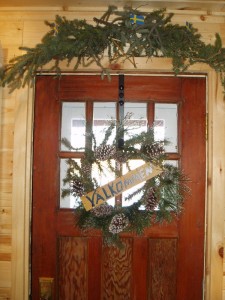 “A Swedish Christmas on the Prairies”
“A Swedish Christmas on the Prairies”
On November 29, 2011, the Lac du Bonnet Museum had the pleasure of sharing with grades one and two from the Centennial School in Lac du Bonnet a traditional Swedish pioneer Christmas celebration. The Hans Erickson cabin was filled to the brim with Swedish décor. The traditional tree boasted handmade paper chains, Swedish flag garland, advent stars, but most importantly the beautiful reindeer each child made and brought with them and put on the tree. Museum staff shared the customs of Sweden with the students, which were common on a Swedish homestead in western Canada. A few games were played, and everyone listened to beautiful carols sung by Iona Plato. The children listened to the stories of the Swedish homesteaders that came and settled in the Riverland area on the East side of the Winnipeg River. The students learned a few Swedish words, listened to poems and short stories, shared some laughter, and enjoyed a visit from Santa or “Jultomten”, who gave them a special “Swedish” treat to take home.
Feedback received from Centennial School
The presentation you created for our Grade 1/2 students was outstanding. The decorating, the selection of music and readings, the game and visit from Santa were all perfectly planned for children of this age. One of the reasons our children were well behaved was because they were engaged in the learning at the museum. You drew them in.
More importantly, from my perspective, was the idea that a group of loving adults carefully planned for the education of children in our community. The saying, "It takes a community to raise a child" was lived yesterday. I tried not to get teary when the little boy on my lap asked, "Can I go hug Santa?". I don't think he will ever forget telling Santa that he missed him and loved him and hearing Santa say, "I missed you too" and "I love you too".
The care that was given to your first educational presentation leads me to believe there will be a successful 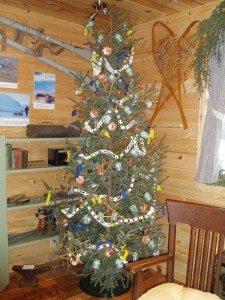 liaison between the museum and our school for years to come.
liaison between the museum and our school for years to come.
Congratulations and many thanks! Leslie
Leslie Wakeman
Guidance and Counseling
Centennial School
November 30, 2011
The following day, the museum was open to the public for two readings first at 7:00 and the second at 8:00. “A Swedish Christmas on the Prairies” was again well received.
Click on pictures to enlarge, To see more pictures of the this event click; Swedish Christmas.





